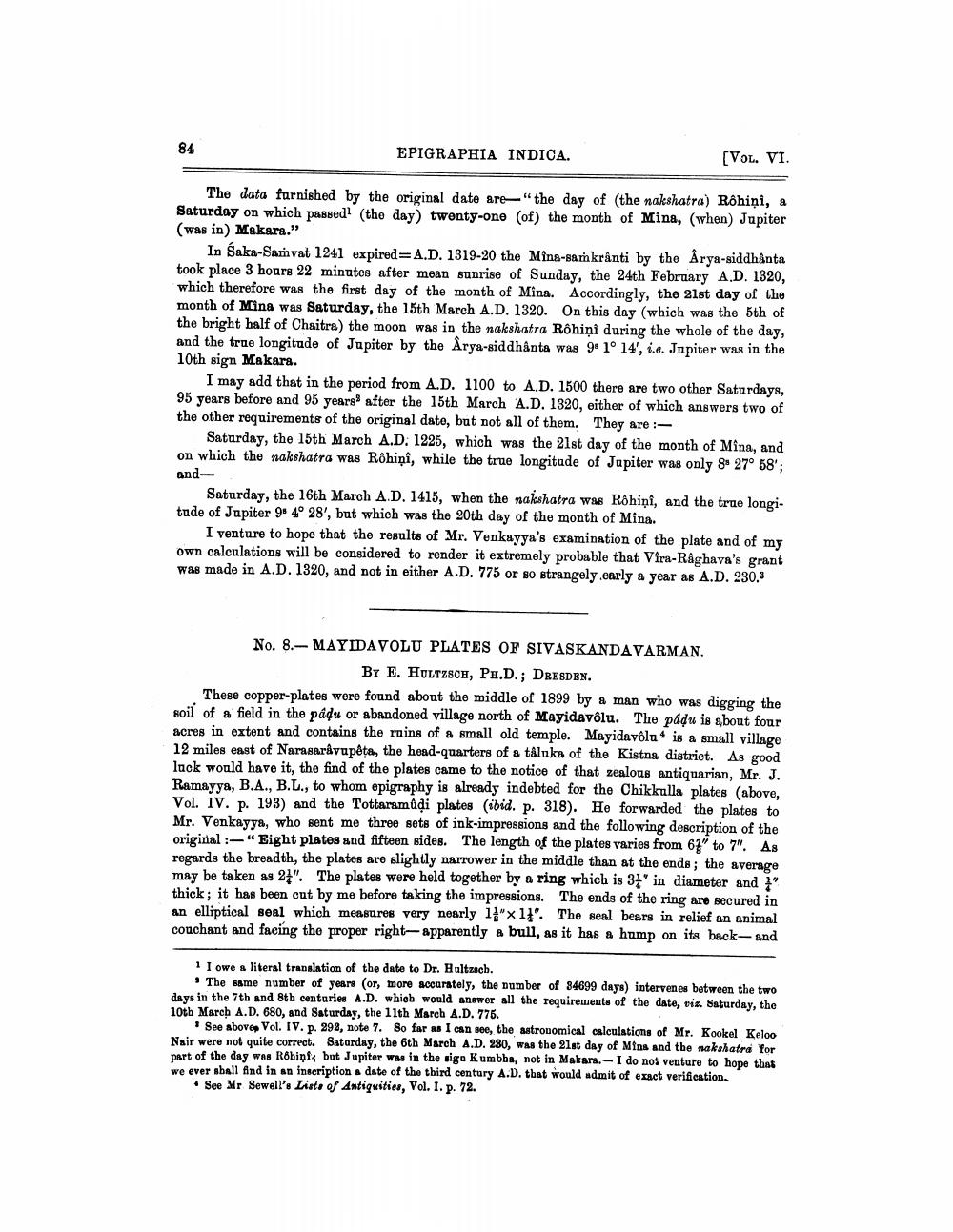________________
84
EPIGRAPHIA INDICA.
[Vol. VI.
The data furnished by the original date are "the day of the nakshatra) Rohini, a Saturday on which passed! (the day) twenty-one of) the month of Mina, (when) Jupiter (was in) Makara.”
In Saka-Samvat 1241 expired= A.D. 1319-20 the Mina-samnkranti by the Arya-siddhanta took place 3 hours 22 minutes after mean sunrise of Sunday, the 24th February A.D. 1320, which therefore was the first day of the month of Mina. Accordingly, the 21st day of the month of Mina was Saturday, the 15th March A.D. 1320. On this day (which was the 5th of the bright half of Chaitra) the moon was in the nakshatra Rohiņi during the whole of the day, and the true longitude of Jupiter by the Arya-siddhanta was 9$ 1° 14', i.e. Jupiter was in the 10th sign Makara.
I may add that in the period from A.D. 1100 to A.D. 1500 there are two other Saturdays, 95 years before and 95 years after the 15th March A.D. 1320, either of which answers two of the other requirements of the original date, but not all of them. They are :
Saturday, the 15th March A.D. 1225, which was the 21st day of the month of Mina, and on which the nakshatra was Rohiņi, while the true longitude of Jupiter was only 8 27° 58'; and
Saturday, the 16th March A.D. 1415, when the nakshatra was Rohiņi, and the true longitude of Jupiter 9° 4° 28', but which was the 20th day of the month of Mina.
I venture to hope that the results of Mr. Venkayya's examination of the plate and of my own calculations will be considered to render it extremely probable that Vira-Raghava's grant was made in A.D. 1320, and not in either A.D. 775 or so strangely.early a year as A.D. 230,3
No. 8.- MAYIDA VOLU PLATES OF SIVASKANDAVARMAN.
BY E. HULTZSCH, PH.D.; DRESDEN. These copper-plates were found about the middle of 1899 by a man who was digging the soil of a field in the pádu or abandoned village north of Mayidavôlu. The pádu is about four acres in extent and contains the rains of a small old temple. Mayidavola* is a small village 12 miles east of Narasarávapéta, the head-quarters of a tâluka of the Kistna district. As good lack would have it, the find of the plates came to the notice of that zealous antiquarian, Mr. J. Ramayya, B.A., B.L., to whom epigraphy is already indebted for the Chikkulla plates (above, Vol. IV. p. 193) and the Tottaramůại plates (ibid. p. 318). He forwarded the plates to Mr. Venkayya, who sent me three sets of ink-impressions and the following description of the original :-"Eight plates and fifteen sides. The length of the plates varies from 67" to 7". As regards the breadth, the plates are slightly narrower in the middle than at the ends; the average may be taken as 21". The plates were held together by a ring which is 31' in diameter and " thick; it has been cut by me before taking the impressions. The ends of the ring are secured in an elliptical sonl which measures very nearly 1}"x 11". The seal bears in relief an animal couchant and facing the proper right- apparently a bull, as it has a hump on its back-and
1 I owe a literal translation of the date to Dr. Hultzsch.
The same number of years (or, more accurately, the number of 84699 days) intervenes between the two days in the 7th and 8th centuries A.D. whicb would answer all the requirements of the date, vis. Saturday, the 10th March A.D. 680, and Saturday, the 11th March A.D. 776.
See aboven Vol. IV. p. 293, note 7. So far as I can see, the astronomical calculations of Mr. Kookel Keloo Nair were not quite correct. Saturday, the 6th March A.D. 280, was the 21st day of Mina and the nakshatra for part of the day was Robiņi, but Jupiter was in the sigo Kumbba, not in Makars.- I do nos venture to hope that we ever sball find in an inscription date of the third century A.D. that would admit of exact verification.
• See Mr Sewell's Lists of Antiquities, Vol. I. p. 72.




